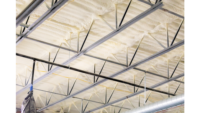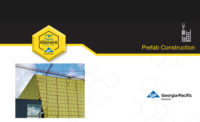The city of Sandy, Utah, is on the rise. Located just south of Salt Lake City, the mountainside town is experiencing rapid development, a product of the capital’s growing population and booming economy.
Preparing for the influx of businesses that are taking root in Utah’s sixth-largest city, developer Synergy Development set out to build a warehouse and office space in Sandy. To save time and money on the job site, the building owner took a concrete tilt-up approach for the exterior. Similarly tasked with finding the most efficient and inexpensive insulation for the tilt-up business park, Capitol Roofing Service opted for a hybrid system with a foundation of expanded polystyrene from Insulfoam.
A hybrid system consists of a base of EPS insulation topped by one or more layers of polyisocyanurate (polyiso) insulation. “It’s good practice to have at least two staggered layers of insulation to prevent thermal bridging (or the movement of heat across an object that’s more conductive than the surrounding materials),” says Daniel S. Barker, owner of Division 7 Specialties, the local Versico rep for Utah. With polyiso’s high R-values and EPS’ stability and reliability—EPS’ R-value remains consistent over time—energy is less likely to escape.”
Two-in-One Solution
Not only does this two-in-one solution afford high-performance but the EPS insulation component specifically solved the biggest problem—project cost. “EPS costs half of what was bid in other insulation options. Even with added fastener costs, the owner still saved double digits per square foot by going with the EPS/polyiso hybrid system,” Jason Wood, Territory Sales Manager for Insulfoam, said.
James Fiscus, Estimator for CRS, confirmed the cost-effectiveness: “Cost was one of the biggest reasons we went with EPS insulation. The owner gives you a budget, and you figure out a way to stay in budget so you can do the job. Whenever you can save on insulation and get the same R-value, that’s a huge benefit.”
“EPS also led to labor savings, as the insulation is easy to use and easy to cut,” Fiscus continues. This freed up construction crews to focus on other, more time-consuming tasks. EPS’ lightweight properties are largely to credit, allowing fewer workers to lift and maneuver the product with ease, quickly placing one layer of 5.13” EPS precisely on the unit.
Adding to the building team’s challenges, the project was constrained by a small work area with little room for storage. “EPS again helped, as fewer people could unload more insulation from a single truck. We were also able to load from the ground [up],” thanks to EPS being lightweight and durable, Fiscus says.
Wrap Up
The final element of the hybrid system is the TPO membrane. Manufactured by Insulfoam’s sister company Versico, 60mil of VersiWeld was laid out over the polyiso, as all three products are compatible. The company used CAV-GRIP 3V’s Low-VOC spray adhesive, which dispenses faster than traditional roll-on adhesives for additional labor advantages, and the company was crucially able to warranty the total system.
“The end-user wants products and systems that work well together and can be more efficient,” Barker says. “The owner and architect were looking for a 20-year warranty, and that’s something we’re able to provide with the hybrid system involving different divisions of Carlisle Construction Materials.”
Topped by the hybrid system, the Synergy warehouse will cover the burgeoning Sandy business community with the longest warranted R-value at the best price now and into the future.
PROJECT NOTES
Project Location: Sandy, Utah
Installer: Capitol Roofing Service
Contractor: Hughes General Contractors
Products:
- EPS Insulation: InsulFoam I 10psi, 5.13” (1 layer)
- Polyiso Insulation: VersiCore 20psi, 1.5” (1 layer)
- TPO Membrane: VersiWeld 60mil White








Report Abusive Comment